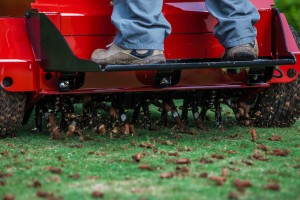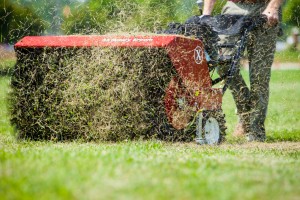In most parts of the country, turf grass growth slows to a crawl as the temperatures cool in the fall. A common question from our customers is when to stop mowing their lawn for the season.
As you might imagine, there’s really not one date where you can say “it’s time to stop”. That said, with a little knowledge of what to look for, it can be a relatively easy question to answer for yourself.
What to Look For
As with many lawn-related questions, the answer to when you should stop mowing is rooted in your geography and the prevailing weather pattern your area is experiencing.

Aeration in the fall helps reduce soil compaction and encourages root growth of cool-season turf types.
According to research published by Cornell University, top-growth (growth above ground) of the lawn slows to a virtual standstill after about 10 days with average daily temperatures below 50 degrees F. At this point, the turf grasses will focus on root growth until the ground freezes.¹
You’ve likely notice the decrease in your lawn’s growth as cooler fall temperatures settle in. By keeping tabs on your local weather, you’ll be able to determine when your daily average temperature goes below 50 degrees F.
Though mowing frequency may decrease significantly, folks who live in warmer parts of the country may end up continuing to mow throughout the year, if simply to keep the lawn looking well-kept. That said, those of us in the upper two-thirds of the country will inevitably end up putting the mower away for a few months.
Cooler Temps = Less Frequency & Lower Cutting Height

The annual growth cycle of cool-season grasses. Source: Cornell University
As temperatures drop and your mowing frequency decreases, you’ll want to finish the transition to the low-end of the cutting height window for your turf grass type. This prepares the lawn for winter by reducing its exposure above ground and encouraging the active root growth that takes place in cooler temperatures.
According to the Iowa State University Extension, you should cut your lawn to 2-2.5 inches for Kentucky bluegrass or tall fescue, and 1.5-2 inches for perennial ryegrass or creeping red fescue.²
Fall is a Good Time to Fertilize
As you transition your cutting height to the lower end of your cut height window, you might also want to consider fertilizing your lawn. This supports the active root growth that’s taking place and fortifies your lawn so it stays healthy through the winter and greens up quickly next spring.
If you still have questions about when to stop mowing, or how to prepare your lawn for winter, contact your local Extension agency or a local landscape professional. Both can be valuable references as you work towards a more beautiful lawn.
Citations and References:
- ¹ “How Grass Grows“, Cornell University. Cornell University, n.d. Web. 31 Aug 2015
- ² Agnew, Michael and Christians, Nick. “Mowing Your Lawn“, Iowa State University Extension. Iowa State University, revised August 2009. Web. 31 Aug 2015







